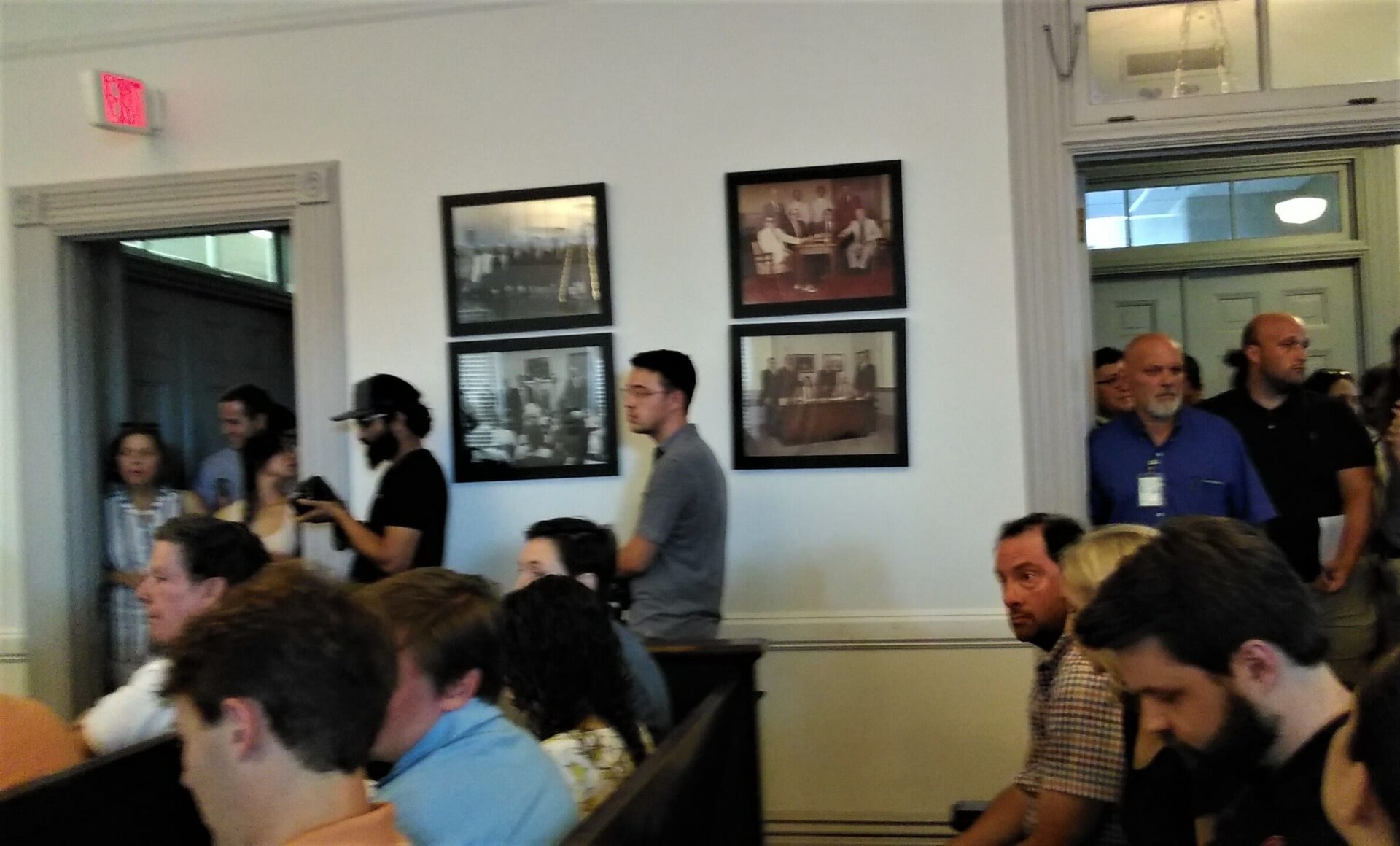Headlines
Oxford Downtown District Boundaries Could Expand
By Alyssa Schnugg
Staff writer
alyssa.schnugg@hottytoddy.com
After the courtroom in City Hall filled to legal capacity Tuesday night during the Oxford Board of Aldermen meeting, citizens piled into the hallway just outside the doors to hear the discussion over whether Oxford needs a Downtown District to help keep the Square safe.
They stood for a long time.
The public hearing lasted three hours with local restaurant and event venue owners asking questions and expressing concerns about the proposed ordinance.
At the start of the hearing, Mayor Robyn Tannehill said the ordinance was still a “working document” and that changes have been made as late as Tuesday afternoon with more expected.
In the original proposed ordinance, the Downtown District was defined as the area west of the Lafayette County Courthouse, beginning on the west side of the Square and proceeding west on Jackson Avenue to include those businesses on the south side of Jackson Avenue to South 10th Street; then proceeding south to the north side of Van Buren Avenue to include those businesses on the east side of South 10th Street, and then proceeding east on Van Buren Avenue to South Lamar Boulevard to include those businesses on the North side of Van Buren Avenue.
However, Tannehill said after having conversations with the businesses inside that area, restricting the Downtown District to the proposed area could leave those businesses at a “competitive disadvantage” with other establishments outside of the District. It could push problems that the proposed ordinance aims to fix—like crowd control, safety concerns and underage drinking—to other parts of the Square where those businesses would not have the same requirements, she said.

Standing-room-only at City Hall Board of Aldermen meeting on June 19, 2018. Photo by Alyssa Schnugg.
“We will look at possibly expanding the District to include the entire Square area, from Chevron to Chevron and from St. Peters to City Hall, or including all business that sells alcohol in the city,” she said. “I haven’t discussed this with the rest of the board (as of Tuesday), but we’re going to look at that.”
Some of those requirements include having at least one security guard for fewer than 50 customers and up to five for events with more than 200 people; having clearly marked lines for where people enter and leave the establishment; security cameras at all entrances and other locations; using age verification scanners and having a safety plan that includes evacuation plans, assault and active shooter response plans.
In the original ordinance, event venues, which are regulated by a state statute, would also be required to adhere to the new regulations and also file a permit, at the cost of $75 per event, for each event with the city. The original ordinance had a clause that said the Oxford Police Department could deny an event. That language is being removed, said OPD Chief Joey East, after the owners of The Lyric issued a statement earlier this week saying that denying certain events could be a violation of First Amendment Rights. The Lyric is the only official event venue inside the proposed District.
“We have no intention of denying any event,” East said. “We just want to make sure there’s a plan in place to deal with crowds and so that we know what to expect.”
Other changes made since the first reading two weeks ago include taking out language that would require cameras behind bars and reduce the time businesses need to save footage from 14 days to seven days. Also removed was a sentence that said all businesses must provide security footage to law enforcement when requested.
“We don’t want to just look at your footage,” Tannehill said. “But if something happens, then we will ask for it through legal measures and legal processes already in place.”
While business owners seemed pleased with some of the changes, many still had concerns over several of the requirements. One, in particular, was the requirement to use age identification scanners—or ID scanners—saying that fake IDs are made to ”fool” scanners and that they are expensive and ineffective.
Hudson Chadwick, owner of Rafters Music and Food, said requiring security to scan every single person or face legal consequences was unreasonable and that, if implemented, there should be some discretion to not have to scan people who are obviously over the legal drinking age.
“I don’t want to get fined because I didn’t scan grandma,” he said. “If Eli Manning stops by and I want to bring him up the back entrance, I should be able to do that without fear of being fined. I know he’s over 21.”
The ID scanner requirement proposed in the Downtown District would only be for businesses that sell alcohol and restrict entrance to those 18 or 21 years old and up. Restaurants open to people of all ages would not be required to use ID scanners.
Restaurant owner John Currence said a task force should be formed to look at the Downtown District and review the ordinance with more public hearings to gain input as the proposed ordinance has already been changed several times since its original form.
Tannehill said the board will schedule a public hearing to be held outside of a regular board meeting—possibly at the Oxford Conference Center to accommodate more people — within the next two weeks. An additional public hearing will be held during the Board of Aldermen’s next regular meeting on July 2, she said.
“The goal is to work with entertainment venues to provide as safe of an environment as we can,” Tannehill said. “We have to have buy-in from everyone. We want this document to be something we can all be proud of.”
The time, date and location of the public hearing will be announced once confirmed via the city’s social media sites and website, www.oxfordms.net, where a copy of the most recent version of the ordinance is available to read online.














